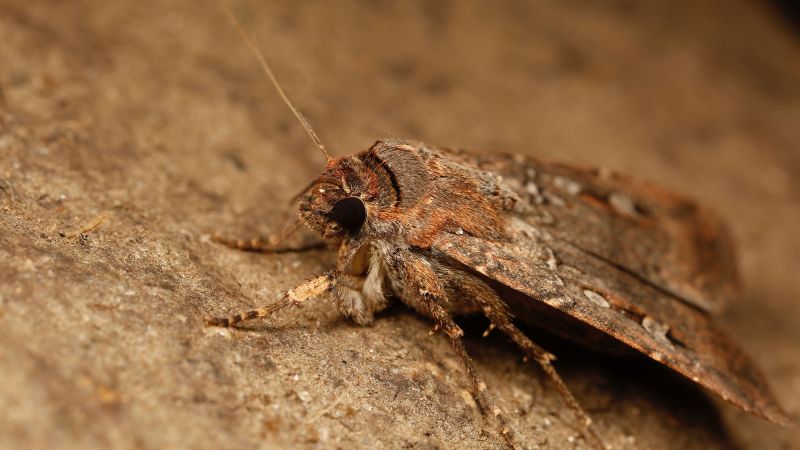A recent study has unveiled the incredible nocturnal migration patterns of the Bogong moths, a surprisingly small but extraordinary species native to Australia. These insects embark on a remarkable journey of 620 miles (1,000 kilometers) each year, traveling from their various habitats across southeastern Australia to the cool caves nestled in the Australian Alps during the spring. Here, they enter a dormant state, only to return in the autumn to mate and ultimately perish. Researchers embarked on an experimental journey to replicate the conditions of this migration, which led them to an astonishing discovery regarding the navigational capabilities of these moths.
Eric Warrant, the head of the Division of Sensory Biology at Lund University in Sweden and coauthor of the study published in *Nature*, remarked on the moths’ navigational prowess, stating, “It is an act of true navigation.” This signifies that the insects utilize the starry night sky as a compass to chart their course. Invertebrates containing such complex navigation systems was unprecedented, indicating a significance not just for this species, but for the evolutionary adaptations of insects as a whole.
However, the stars are not the only instruments in the Bogong moths’ navigation toolkit. Previous research conducted by Warrant and his colleagues indicated that the moths are also capable of detecting the Earth’s magnetic field. This dual cue system provides them with a safety net to ensure accurate navigation — a remarkable feature indeed, particularly considering the uncertainty presented by adverse weather conditions like cloudy nights or magnetic anomalies. Warrant emphasized the impressive capabilities of the moths, saying, “With a very small brain, a very small nervous system, [the moths] are able to harness two relatively complex cues and not only detect them, but also use them to work out where to go.”
Belonging to the species Agrotis infusa, Bogong moths are entirely nocturnal. Measuring about 2 inches (5 centimeters) in wingspan, they possess a nondescript brown appearance that may often go unnoticed. However, in recent years, their populations have sharply declined to the point of being classified as endangered on the International Union for Conservation of Nature’s Red List. Warrant has been studying these insects for over five years, particularly fascinated by their ability to sense the Earth’s magnetic field and the potential role of visual cues in navigation.
To explore his hypothesis, Warrant set up an experimental laboratory about 93 miles (150 kilometers) from where the moths migrate, using light traps to capture the insects. Once captured, the researchers attached a thin, nonmagnetic rod to each moth. This rod enabled researchers to monitor their flight patterns and navigation decisions while ensuring they could test the moths’ reliance on visual cues by isolating them from Earth’s magnetic influence through a device that generated a magnetic vacuum.
What they discovered was illuminating: the moths consistently flew in their inherited migratory directions. Warrant demonstrated the moths’ impressive abilities to utilize the projected starry sky, mimicking the actual conditions outside during the experiment, reinforcing the moths’ reliance on celestial navigation.
Approximately 400 moths were analyzed in this behavioral experiment, and all were safely released afterward. Researchers also collected a smaller sample to study the neural mechanisms behind this navigation. Warrant noted that while the moths have limited eyesight due to their small pupils, they can perceive the dim nighttime world with heightened sensitivity. Remarkably, they can see this world 15 times brighter than humans, enabling them to navigate by the Milky Way with unprecedented clarity.
Despite birds and humans being well-known navigators via celestial cues, the Bogong moth’s unique migratory abilities set them apart. Notably, this incredible journey is undertaken only once in their lives, indicating that their navigation skills are inherently instinctive. “Their parents have been dead for three months, so nobody’s shown them where to go,” Warrant confirmed, marveling at their innate understanding of their destination.
This new understanding raises many intriguing questions about the nature of moth navigation. Jason Chapman, an associate professor at the University of Exeter, emphasized the necessity for further research in understanding the specifics of the moths’ detection, the integration of their navigational methods, and the extent to which these mechanisms might apply to other nocturnal insects.
The findings enrich our comprehension of insect migratory behavior, revealing the complexity with which these creatures traverse vast distances without the guidance of their forebears or a detailed map. Professor Jane Hill from the University of York highlighted the impressive ability of the Bogong moths to navigate despite generational gaps, contributing to a larger discourse on navigation methods both in insects and across the animal kingdom. As experts continue to explore the nuances of moth migration, each discovery uncovers a layer of the remarkable world of these creatures that works tirelessly amidst the vastness of nature.



